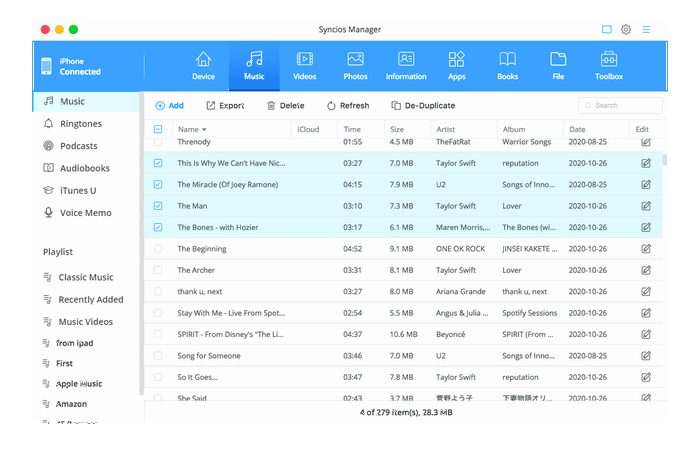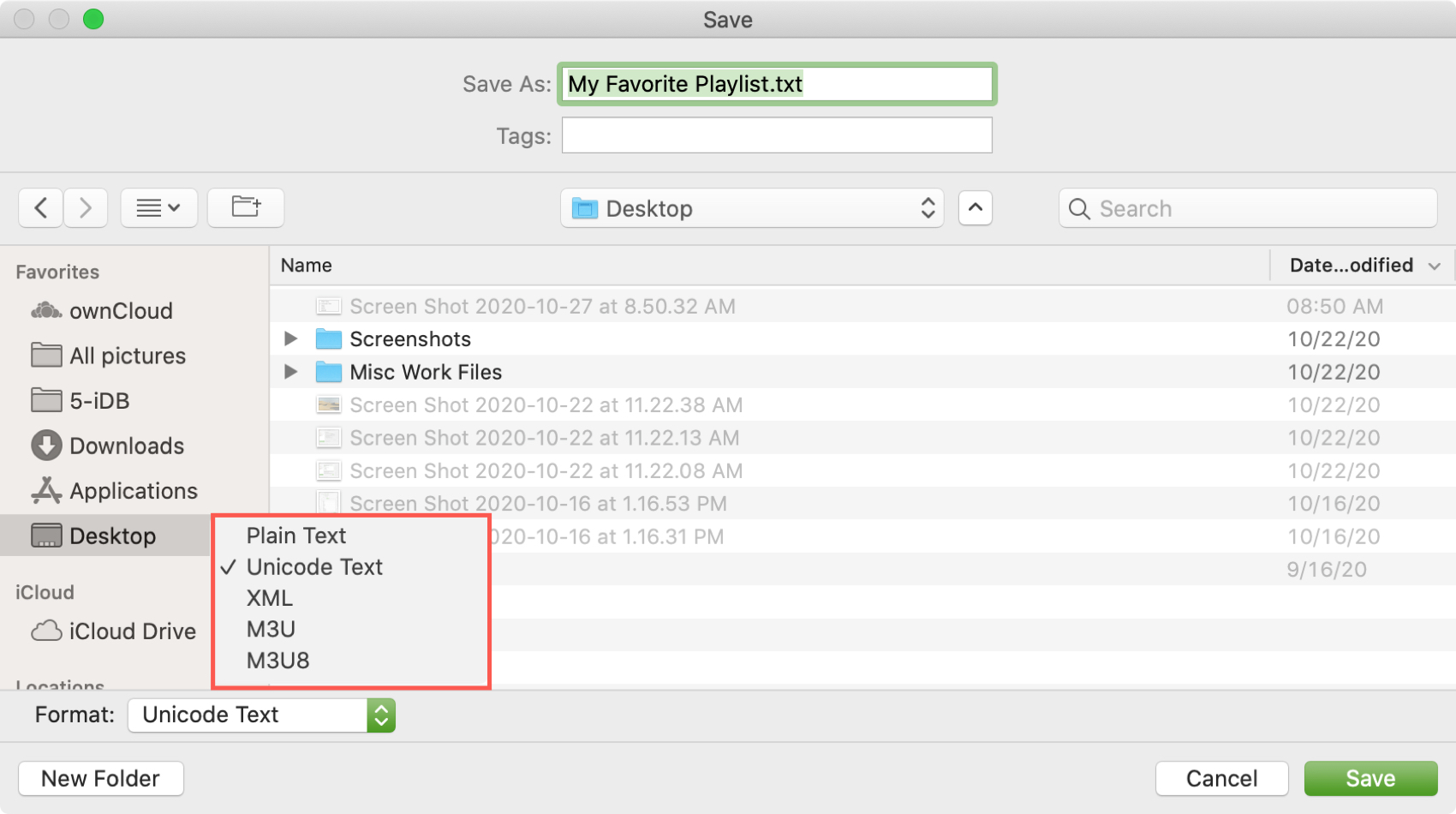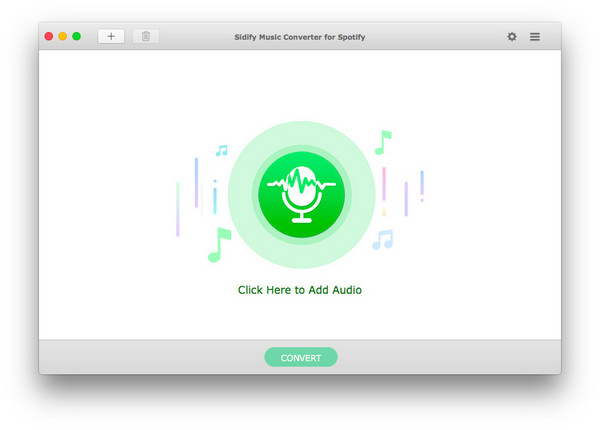It is a piece of cake to import your local files or iTunes playlist to Spotify, however, it is pretty tough when exporting any songs or playlists from Spotify back to iTunes library and Apple Music. Since Apple Music was launched in late 2015, it has won the hearts of many Spotify users, especially those deeply entrenched into Apple-ecosystem. If you’ve been using Spotify for the past few years, you’ve probably got a lot of carefully curated playlists of your own and hope to transfer your favorite Spotify music to iTunes library and Apple Music for enjoyment. To solve the problem, we show you how to import your songs and playlists from Spotify to Apple Music and iTunes library in 3 different ways.
There is no official tool to help switch the playlist between Spotify and Apple Music yet. To get it work, we need the help of third-party software. After much research, we’ve found three fairly reliable third-party services that work well. They are called STAMP, Move to Apple Music and Spotify music converter. The service would help you export the Spotify playlists to Apple Music without manually recreating them one by one.
So I ended up writing an app to do this, based on this thread: to export Sonos playlists, Favorites, Radio stations, and Alarms. It exports as human-readable (so you can manually do whatever you want with it) and machine-readable (for more advanced usage). Go to the iOS App Store and search for “sonos export playlist” and you’ll find it. Check out the playlists in your Music app. If the iTunes duplicate playlists problem still exists, try other solutions. Delete the affected playlists from Music on your device. We can also manually delete all the duplicate iTunes playlist and sync with iPhone again to remove duplicate playlist in both iTunes and iPhone. Premium users get the ability to export playlists as CSV, TXT, JSON, and URLs. Playlists can also be combined into one large playlist or separated into smaller playlists before being transferred.
1. Transfer Spotify songs and playlists to iTunes Library via Spotify Music Converter and iTunes
As we know, the Spotify music is encoded with DRM which means you are unable to play the songs in Spotify on devices that does not install Spotify app. Even you are the Spotify Premium subscriber, you would also fail to listen to the offline downloaded Spotify songs through any media player. To make it possible to enjoy Spotify on iTunes, this method helps exporting the Spotify songs and playlist as DRM-free ones, and then add them to iTunes library.
Step 1: Pick the playlist in iTunes music application that you want to export. Step 2: Click the 'File' iTunes app. Step 3: Select “Library” “Export playlist”. Then choose the location to save the playlist file. Step 4: Select the 'Save as type' menu to get the format options. Step 5: Choose a playlist file name and save it. With a subscription to Apple Music, you can enjoy Apple Music songs on iPhone/iPad/iPod Touch/Android via Apple Music app, you can also access your music across iTunes on PC or Mac, as long as you're signed in to Apple Music with the same Apple ID, but some mobile phone and devices without Apple Music app supported, such as Windows Phone.
Requirement:
Spotify installed
Spotify Music Converter installed
iTunes installed
Windows or Mac computer
Spotify Music Converter is a light and powerful Spotify to MP3 converter which aims to convert Spotify music to plain audio files such as MP3, AAC or lossless WAV, FLAC with original quality kept, retaining the ID3 tags. Both Windows and Mac versions are available. We set the Mac version as example.
Launch Spotify Music Converter, drag and drop your favorite song or playlist from Spotify to the application. The program would detect the songs and list them on the main panel for conversion. Then go to the settings to choose the output format and audio quality. You may also leave it as default. The default setting is output to MP3 with 256 kbps audio quality. The conversion speed can be maximum to 5x.
After pressing the Convert button, what you need to do is wait. The program would begin the conversion process automatically. Through the history button on the top right, you can easily know how much songs are converted successfully.
These downloaded Spotify songs are MP3 audios and can be imported to iTunes library easily like any local files. Launch iTunes, move to menu bar File > Add to Library…, locate the destination folder of the converted Spotify songs. That is the end. You would find the songs under iTunes library and start to enjoy now.
Pros:
- The converted songs can also be added to MP3 player, transferred to USB or burnt to CD.
- The converted songs are with detailed metadata.
- Excellent audio quality output.
Cons:
- The Spotify music converter can only convert 3 minutes of each song in trail.
2. Move Spotify Music to Apple Music or iTunes via STAMP
STAMP is a simple-to-use application that helps to transfer music/playlists from Spotify, Rdio and CSV file to iTunes and Apple Music.
Requirement:
Spotify installed
STAMP installed
iTunes installed
Apple Music subscribed
Exportify
Windows, Mac, iOS or Android OS
Before you get started, make sure you are logged into iTunes with your Apple ID and subscribed to Apple Music.
First, export your Spotify playlists to a .csv file using Exportify ( log with your Spotify account).
1. Go to the STAMP website and download the app.
2. Open iTunes and head to either the “For You” or the “New” tab.
3. Open STAMP and select the .csv file you want to import.
4. Click parse and wait for the application to finish importing.
During the waiting time, don’t touch your computer until the whole process is completed. As the app simulates clicks and keystrokes so if you click elsewhere you will mess it up.
The app recreates the playlist directly into your music library. They find and add tracks from Apple Music automatically. You must manually create a playlist after the tracks are added. Its free version works with 10 songs in a playlist, while the paid version can handle huge playlists.
Pros:
- Available for Windows, Mac, iOS and Android OS
- Easy operation
- Can export anything that works with Expotify

Cons:
- Slow
- Can’t touch the computer while the app is working.
- The app must be given special permission to control your computer.
3. Import Songs or Playlist from Spotify to Apple Music or iTunes via Move to Apple Music
Move to Apple Music, similar to STAMP, also provides an easy way to transfer music and playlists from Spotify and Rdio to Apple Music and iTunes.
Update: We noticed that Move to Apple Music is no longer provide the service due to the incompatible issue with macOS update since November 2016.
Requirement:
Spotify installed
Move to Apple Music app installed
iTunes installed
Apple Music subscribed
Mac computer
1. Download the app through Move to Apple Music website. Launch the program and select “Spotify” where you playlists are located.
2. Log into your Spotify account and allow Move to Apple Music access to the app. A list of playlists fetched from your account will be displayed. Choose the playlists that you’d like to move to Apple Music and hit “Next”.
3. The app needs to capture an iTunes session to transfer the selected playlists from Spotify to Apple Music. Click “Capture Session” and open iTunes. Once it’s launched, start liking any songs you like in your library into you see “Yes”.
4. After that, the app will start to check your tracks and transfer music from Spotify to iTunes. After the transfer has been completed, click the “Save My Playlist Files” button and choose the location where you’d like the file to be saved on your Mac.
5. Now go back to iTunes and click “File” > “Library” > “Import Playlist” and choose the saved file. The playlists will now be imported into Apple Music and iTunes.
Pros:
- Easy operation
- Allow you to move playlist from Spotify or Rdio to Apple Music
Cons:
- The app must be given special permission to control your computer.
To sum up, the above 3 solutions are currently the best ways to transfer songs and playlist from Spotify to iTunes library and Apple Music. As Move to Apple Music shuts down its serve since Nov 2017. You could try either Spotify Music Converter or STAMP to achieve the goal.
The advantage of using Spotify music converter to move the Spotify music to iTunes is obvious. The app exports the Spotify songs and playlists as MP3 in excellent quality. And what you have to do is import the converted Spotify songs to iTunes library. The whole operation is simple and easy. What’s more, the converted Spotify songs can be played via more devices such as MP3 player, iPod, Walkman…It is best for people who want to transfer the Spotify music to iTunes/Apple Music, as well as enjoy Spotify music in the car, during walking, running…
The STAMP provides other way to import the Spotify playlist to Apple Music and iTunes. You need to export the csv file, then use the app to transfer. The operation is also simple and easy. But pay attention, it does not allow you touching anything on the computer while processing.
If you’re looking for an easy way to move Spotify playlists over to Apple Music, then look no further.
(173 votes, average: 4.99 out of 5, rated)Loading...Discover the newest way to batch tag and rename audio files using the handy spreadsheet.
TAG EDITOR ALLOWS YOU EASILY AND QUICKLY:
Handy Spreadsheet for Quick Tagging
Meet the Tag Editor for Mac, a spreadsheet application for editing audio metadata in a simple, fast, and flexible way.
This audio tag editor supports various audio formats, ID3 tags for WAV, AIFF, FLAC, MP3 files, XIPH/Vorbis Comments for the FLAC files, and MP4 tags for M4A and MP4 files.
'... makes it easy for you to organize your music files, without having to go through complicated procedures.' |
- mac.softpedia.com |
large music collections easily.' |
- macdownload.informer.com |
COLUMN AND ROW MANAGEMENT
The app's primary purpose is to represent, edit, and process the audio metadata in a structured way. The application has easy to follow layout - the spreadsheet window with the toolbar and the table containing rows and columns. The app can open a few spreadsheet windows or tabs simultaneously.
Each rowrepresents an audio file and its metadata and technical information. The metadata editor can load up to 200000 audio files in one spreadsheet.
A column represents particular metadata or audio data type. You can edit more than 60 audio tags in corresponding columns, including, but not limited to Album, Artist, Title, Artwork, Comment, Lyrics, Genre, Grouping, Key, Track Number, Year, and others. Audio's technical properties, like Audio Codec, Audio Format, Bit Rate (kbps), Channels, Size, and others, can also be shown and used for composing the other tags.
For better accessibility, the 'Columns' menu has organized sets of columns or tags, like Classical, Commerce, Mood, People, Podcast, Sorting, and others.
The columns can be rearranged and sorted easily. One or more sorting criteria can be applied to sort each column.

Column and Row Management
CHANGING TAGS INSTANTLY
With this metadata editor, audio tagging is not a tedious and tiresome job anymore.
Change the audio metadata with ease. Apply a Batch Tagging, Cut, Copy, Paste, Undo, Find and Replace, to a range of selected cells or the entire spreadsheet.
Batch Export Playlists Music App Mac Os
You can load, change, and control all changes in one spreadsheet window using the keyboard shortcuts. It can significantly speed up workflow and be especially convenient for laptop users. Tidy your entire audio collection with both auto and manual methods quickly and easily!
Change Tags Instantly
Batch Editing of ID3 tags, Copy, Paste, Find and Replace
CONTROL OF CHANGES
When the changes have been saved, they go immediately to the audio files. So, it makes sense to review the changes before applying them. The spreadsheet format makes it easy to review the changes and eliminate unwanted mistakes.

Use the app to identify inaccuracies and duplicates in your audio tags. All the changes you have made are highlighted and become visible.
The unwanted changes can be reversed with the Undo or Reload commands.
Control of Changes
IMPORTING TAGS FROM ONLINE DATABASES AND ITUNES
The application supports the automatic importing of audio metadata from online databases, such as MusicBrainz, AcoustID, CoverArt, etc. The metadata loader can also parse and load tags from path components, such as folder or file names.
To import tags from iTunes, drop iTunes playlist to the Tag Editor, select a few Rating cells, for example, and choose Edit / Load Tags / From iTunes (Music).
Read More: Importing Artist, Album, and Title from Online Databases >>
Read More: Importing Secondary Tags from Online Databases >>
Read More: How to import Genres and Tags from online databases? >>
Read More: How to embed ISRC codes from online databases into MP3 files? >>
Read More: How to improve the performance when importing tags from online databases? >>
Read More: Automatic Loading of Audio Tags >>
Loading Metadata from Online Databases,
Path Components and iTunes / Music
SETTING ARTWORKS
The Tag Editor can search for artworks in online databases, such as CoverArt, Discogs, MusicBrainz, AcoustID, etc. So, select a few artwork cells, and choose Edit / Load Tags / From Network.
The app also can load album artworks from local folders automatically or manually.
Setting Artworks and Improving Tags
Playlist
CLEANING UP AND IMPROVING TAGS
The metadata editor provides built-in commands for improving existing tags:
- Fix Encoding - converts the metadata to Unicode and makes it readable.
- Change Case - changes the case of the metadata.
It becomes easy with the app to get rid of unwanted and low-quality audio tags.
RENAMING FILES
Tag Editor is ideal for editing and renaming files with the use of audio tags. Spreadsheet format allows you to check, edit, and automatically standardize multiple filenames in a single table.
File names can be changed in auto or manual mode as well.
Read more: How to rename files with the use of audio metadata >>
Read More: Export to Music / iTunes >>
Read More: Export to Audio Playlists >>
Read More: Export to Text and CSV files >>
Batch Export Playlists Music App Mac

Renaming Files and Exporting Files to iTunes
TECHNICAL SUPPORT
Please, write to us about feature requests or any problems. We always glad to improve our applications for your needs. If you like the Tag Editor, a review of it at the App Store would be appreciated.